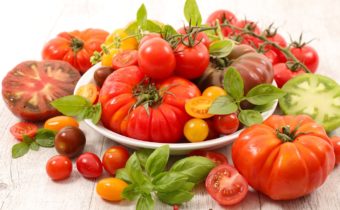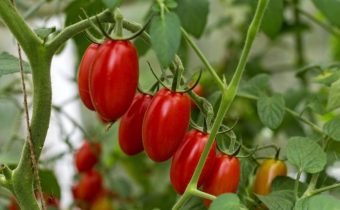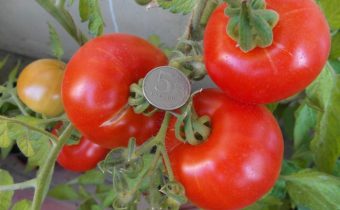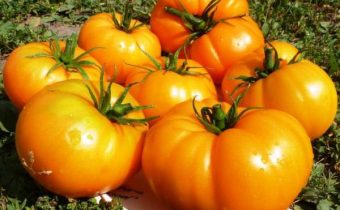Tomato "Red Bunch": beautiful, tasty and fruitful
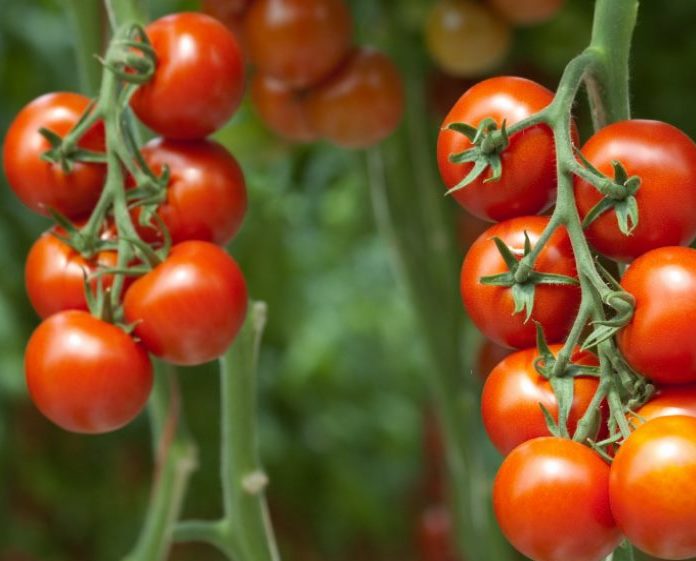
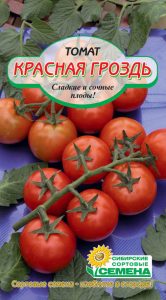 Any summer resident or a gardener wants to plant such tomatoes on the plot that will be beautiful, will give a huge harvest of very tasty tomatoes. Spring is just around the corner, and February is on the threshold. After about two to three weeks, it is time to sow the seeds for seedlings.
Any summer resident or a gardener wants to plant such tomatoes on the plot that will be beautiful, will give a huge harvest of very tasty tomatoes. Spring is just around the corner, and February is on the threshold. After about two to three weeks, it is time to sow the seeds for seedlings.
And tomato varieties are an enormous amount. The problem of choice arises: what varieties of seeds to buy, what varieties of seeds of the past season did they like, which sow, and which ones did not. In a friendly tomato family, there is one such: small, but remote - a Red bunch. This variety has confidently won the sympathy of gardeners, gardeners, farmers, and even those who grow tomatoes on an industrial scale.
Red Cluster tomato is popular among amateurs, gardeners, in their reviews they give him an excellent characteristic, confirm his description of the variety with their photos of tomato bushes hung with ripe fruits. These tomatoes love and appreciate everyone who loves tomatoes in general.
Characteristic and description
Any vegetable, including a tomato, is distinguished by certain, individual qualities. To help gardeners, gardeners given a description and description of a particular variety, including tomato and red cluster:
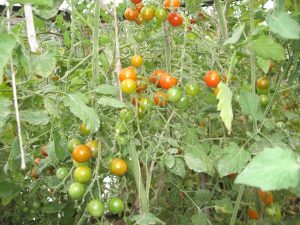
- determinant: the tomato itself limits its growth;
- early maturing: tomatoes ripen for 90-100 days after emergence;
- bush low, compact; grows to 40-50 cm;
- stalk chunky, strong, thick;
- it is better to pinch the top to make a bush branchy;
- he must stepchild;
- leaves are simple, potato, without pubescence, dark green, corrugated;
- inflorescences are simple; the first appears above the 6-7th leaf, the next — every pair of leaves;
- in this variety, the roots are quite powerful, expanding far in breadth;
- bunch of tomato brush;
- about 20-25 small tomatoes ripen on one brush;
- small-fruited variety, but fruitful: up to 4-4.5 kg of tomato can be collected from one bush;
- stably fruits throughout the season (about 3.5 months), abundantly;
- the first ripe fruits appear already in the second half of June; fruits almost until the beginning of October;
- to growing conditions is not exacting, unpretentious;
- peduncles and articulations fasten firmly to each other, which does not allow the fruit to fall;
- good resistance to temperature extremes and weather changes;
- high degree of keeping quality;
- excellent transportability;
- shoots appear evenly;
- fruiting smooth, friendly, abundant;
- the first ripe fruits appear already in the twenties of June; fruits a tomato until the beginning of October.
Characteristics of the variety is not complete without information about the tomatoes themselves. Indeed, to date, many of them are different.
Fruit
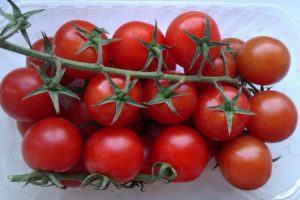
- tomatoes oval, rounded;
- the average weight is 20-40 g; with more careful care, tomatoes are weighing 55-60 g;
- unripe tomatoes are light green in color, the stalk has a dark spot;
- ripe tomatoes are bright red;
- three-chamber with a small amount of seeds;
- thin skin, but dense, glossy, silky; makes tomatoes resistant to cracking;
- taste sweet, rich;
- the solids content is minimal;
- aroma is saturated, tomato;
- pulp is fleshy, juicy, tender.
The yield of the variety of tomatoes Red bunch is confirmed by many photos and reviews of those who have already grown these magnificent tomatoes on their beds.
Purpose
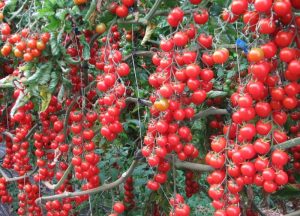 Appointment dessert, salad, universal. These tomatoes are great for whole-canning, are a delicious treat for children. Since the content of dry substances in tomatoes of this variety is low, the fruits are excellent for the production of tomato juices, pastes, adzhik, and other types of technical processing of tomatoes from them.
Appointment dessert, salad, universal. These tomatoes are great for whole-canning, are a delicious treat for children. Since the content of dry substances in tomatoes of this variety is low, the fruits are excellent for the production of tomato juices, pastes, adzhik, and other types of technical processing of tomatoes from them.
The grade the Red bunch with huge success is used for cultivation on an industrial scale; very popular among farmers. They are attracted not only by high yield and excellent taste, but also by remarkable commercial qualities: excellent keeping quality and high transportability.
See also: Magnificent hybrid of tomatoes "Openwork F1"
Story
The variety is bred by domestic breeders and Agroni LLC. It is included in the State Register in 2008 as a tomato, which can be grown in open and closed ground throughout the territory of the Russian Federation. The variety is excellently grown in open beds not only in the southern regions, but also in central Russia, in colder regions this tomato is better to grow in greenhouses.
Disease and Pest Resistance
Because of its early ripeness, the Red Bunch Tomato leaves most of the diseases of the nightshade. The high resistance of this variety to powdery mildew infection and late blight disease has been revealed.
In general, varieties of the Red bunch a good immunity. In order to prevent the possibility of a disease of a tomato with various diseases and to prevent its damage by pests, it is easiest to take simple preventive measures that will help the tomato to stand and not get sick:
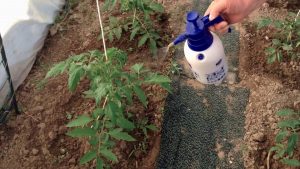
- feeding plants, you should carefully observe the specified dosage, the necessary balance of minerals in fertilizers;
- carefully pinch, loosen, etc. to prevent physical and mechanical damage to the bushes, which can provoke diseases;
- mulch between the rows of soil that protects it from drying out, and also improves the structure of the soil;
- observe the terms of sowing seeds, planting seedlings on the garden bed;
- observe the necessary distance between the bushes of tomatoes;
- before short frosts in spring and autumn, use late (after 21 hours), but abundant watering, which will protect the plants from a sharp temperature drop;
- in greenhouses, carefully monitor the light, temperature, and humidity levels;
- periodically feed tomatoes with mineral fertilizers;
- to protect against most pests near tomato bushes, plant medicare plants (for example, mustard, tagetes or marigolds, calendula, spicy herbs, serpentine, parsley, Chinese cloves, etc.);
- inspect plants regularly for infection or insect damage;
- spray bushes with insecticides and fungicides in case of illness or attack by pests.
Advantages and disadvantages
The grade the Red cluster, as well as any other plant, has the both positive, and negative lines.
Advantages:
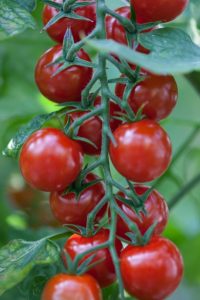
- long fruiting period (about 3.5 months);
- early ripeness;
- high yield;
- the formation of many brushes with a huge number of fruits;
- tomato ripening smooth, even;
- great taste;
- good keeping quality;
- transportability;
- resistance to cracking;
- strong immunity;
- resistance to temperature extremes;
- not subject to drastic weather changes;
- use is universal.
No wonder the Red cluster is very popular not only among private traders and amateurs, but also among farmers and industrialists.
disadvantages
But there are very few or no shortcomings in the variety: after all, what is a disadvantage for someone is an advantage for another:
- in regions with a cold climate can only grow indoors;
- does not like drafts. Because of them increases the likelihood of late blight.
There are no other comments and complaints about the Red cluster.
Features of growing varieties
There are no special conditions for successful growth and fruiting in the Red cluster. Agricultural technology is the same as for other varieties of tomatoes.
How to prepare seeds
Cultivation begins with the preparation of seeds for sowing.
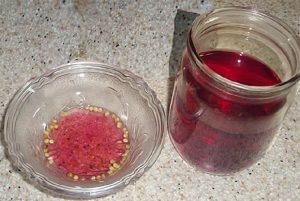
- It is very good to first soak the seeds in a rich pink solution of potassium permanganate for 30-40 minutes to decontaminate them and saturate them with trace elements.
- Then they should be washed with warm water and left in the water for a day, periodically changing it.
- Seeds can still be soaked for thirty minutes in a solution of humate, zircon or other stimulant.
- Then they should be dried and spread on the surface of a well-moistened soil at a distance of no more than 2 cm between the seeds. You can put next to 2-3 tomato seeds.
- Then sprinkle with soil 1.5 cm tall.
See also: Tomato "Dwarf": unpretentious fruitful varieties
Growing seedlings
Seeds for seedlings need to be prepared in the 20th of February.
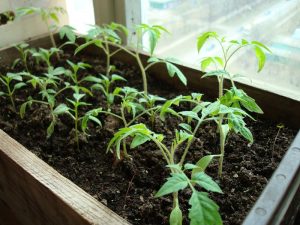
- the container with the seeds sown should be covered with plastic wrap or put it in a plastic bag;
- a couple of times a day, open the package for 1-2 minutes to air out and prevent mold, moss and so on;
- after the emergence of germs to remove the film;
- you can moisturize with a syringe (without a needle), a pipette, enema, etc., try to get between still weak and tender sprouts;
- if the soil is sufficiently nutritious, then it is not necessary to feed the seedlings so that it does not start to “fatten”;
- after the appearance of 2-3 leaves, the seedlings can be very carefully sprayed with a solution of humate, zircon or other top dressing (be sure to respect the dosage!)
- if there is still not enough daylight and the seedlings begin to stretch, it should be lighted up with special fitolamps;
- grown seedlings need to prepare for planting in open ground (for greenhouses - optional): gradually accustom the plants to open air and sunlight;
- to start carrying a container with slightly grown bushes to the street (you can go to the balcony), first - in cloudy weather, so that in bright sunlight plants do not get sunburn.
Carrying in the greenhouse
In indoor soil, seedlings can first be transferred in tanks, give it there a few days for adaptation.
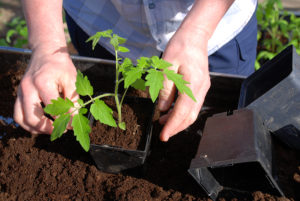
- It is possible to transplant bushes from the tank into the ground, when there are already 5 true leaves on the plant, and the seedlings have reached a height of about 25 cm (one can plant on an open bed a week later);
- it is important to choose a place: the plants should have enough air and light;
- the distance between the bushes should be at least 50 cm;
- planted better square-breeding method;
- rows should be directed from north to south, which will allow plants longer and better illuminated by the sun;
- if the seedlings were not accustomed to open air and direct sunlight, the first time the bushes is better to shade;
- It is best to plant seedlings when the weather forecast promises several cloudy days - this will allow the bushes to better adapt to the new conditions.
How to shape bushes
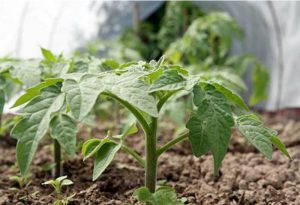 Plants varieties Red cluster in a special formation does not need. The only thing you need: pinch the tops on the bushes.
Plants varieties Red cluster in a special formation does not need. The only thing you need: pinch the tops on the bushes.
In this case, the bushes will begin to branch more, respectively, on the new branches will also appear brushes with fruits.
Red cluster of tomatoes need to pasynkovanii. Remove stepchildren need to, so that they do not take away the nutrients from the uterine bush.
In this case the bush will direct all forces to the growth of the cyst and the formation of fruits.
Garter
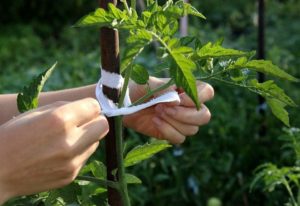 Low-growing bushes of the Red cluster should be tied up so that brushes with a large number of tomatoes do not lie on the damp ground. It is better to install pegs or other supports for tying up immediately upon planting seedlings into the ground, in order not to damage the extensive root system of tomatoes later.
Low-growing bushes of the Red cluster should be tied up so that brushes with a large number of tomatoes do not lie on the damp ground. It is better to install pegs or other supports for tying up immediately upon planting seedlings into the ground, in order not to damage the extensive root system of tomatoes later.
Tying bushes will allow tomatoes to bear fruit for a long time and successfully, without being damaged by fungal diseases. It is better if two or three plants are planted in one hole, so they support each other, grow and bear fruit.
How to fertilize
For all the growing season, tomatoes can be fertilized 2-3 times, no more. It is harmful to overfeed the plants - they begin to build up the leaf mass (fatten) instead of nourishing flower brushes or feeding ripening fruits.
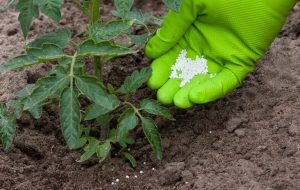
- mineral fertilizers should be given before the start of fruit formation;
- Organic matter (mullein, chicken manure) is good for the first time to make during the formation of ovaries (10 liters of water +1 kg of organic matter) Watering should be at the root of 2-3 weeks so that the solution does not fall on the leaves;
- fruiting period: in 1 liter of water add 1 kg of organic matter or green mowed grass (the flax extract should ferment). Add any mineral fertilizer for tomatoes or nightshade (1 tbsp);
- in the second or third decade of June, it is useful to spray the plants with a solution of urea (urea - 1 tbsp. + potassium permanganate - 1 g per 10 liters of warm water);
- fruiting period: spray the bushes with a solution of potassium sulfate or potassium nitrite, or potassium magnesia (add 1 tablespoon of fertilizer to 10 liters of water). The main thing is that the solution does not fall on the tomatoes.
See also: Tomato "Catherine the Great f 1" - a variety that does not have flaws
How to water
Watering plants should be as the soil dries with warm, settled or rain water.
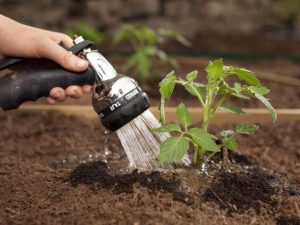
- It is advisable not to allow moisture on the leaves and fruits.
- After watering, the soil should be plowed so that a crust does not form and does not block the access of air to the roots.
- Watering is better in the evening.
- Watering is necessary so that the moisture penetrated to a depth of about a spade bayonet.
- Between irrigation it is good to carry out the so-called “dry irrigation” - i.e. loosening the soil.
- It is impossible to excessively re-moisten the beds and increase the level of humidity (especially in buried soil).
No wonder many gardeners notice that the variety Red Bunch - a stream of sweet tomatoes falls from the bush. Very fruitful, and, moreover, unpretentious, non-capricious, long-fruiting tomato is becoming more common and gaining popularity.
Adults and children like to eat the red bunch - they like to feast on sweet tomatoes not only in salads and other dishes, but also simply to eat them fresh whole, not afraid to sprinkle someone near with juice from a bursting large tomato.With tomatoes Red bunch this just can not happen, as evidenced by convincing reviews of fans of this culture.
Video: First care for tomatoes after disembarkation


 (1 ratings, average: 4,00 from 5)
(1 ratings, average: 4,00 from 5)